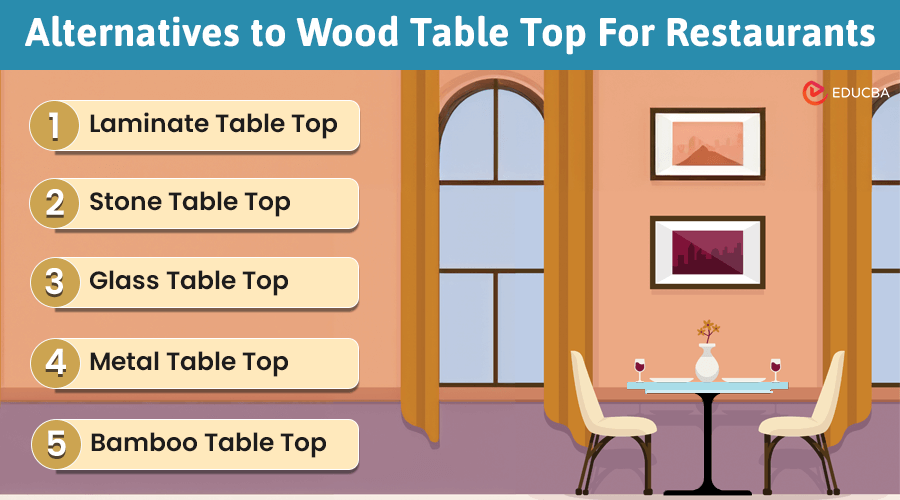What are the Top Alternatives to Wood Table Tops For Restaurants?
For generations, restaurants have used traditional wood table tops. However, with the growing need for sustainability, increased durability, and aesthetics, the need for innovative alternatives is also growing. They not only enhance the dining experience but also align with contemporary trends. In this article, let us see a variety of alternatives to wood table tops.
Here is a brief list of all the alternatives to wood for restaurant table tops.
#1. Laminate Table Top
To create solid core laminate, also known as HPL (High-Pressure Laminate) or compact laminate, manufacturers use machines that layer cellulose fiber material (like paper), coat with thermosetting resins, and bind them together under high-pressure. Solid core laminate tops are especially common among restaurants with outdoor settings as they can withstand rough weather.
Features:
- It is a robust material, frequently just 10 or 12mm thick.
- It is resistant to cleaning agents, scratches, heat, and impact.
- The edges are typically straight, rounded, or chamfered (making them look even sleeker).
- The core is always black or brown. However, it might be white if the top is likewise white. It is also available in a broad range of hues and effects.
#2. Stone Table Top
The two most common stone tops are marble and granite, with granite being more practical and long-lasting but less aesthetically pleasing. On the other hand, marble is more beautiful, but it is also much more costly and fragile.
Features:
- Stone tops come in various materials, forms, sizes, as well as edge profiles.
- They are weighty, loud, and may be unexpectedly delicate.
- The typical size has a 20mm thickness.
- Consider choosing rounded edges, as the sharp corners and edges of square tables are prone to chipping.
- Because of their alkaline makeup nature (materials or finishes with higher pH levels), they are especially prone to stains from acidic substances like wine, cleaning supplies, and tea.
Tips:
- Coat natural stone and concrete countertops with lacquer since they are permeable (can absorb liquid).
- Sand the surface before applying coats to avoid stains and yellowing.
- Use thoroughly glazed plates to prevent scratching of stone tables.
- Take special care when attaching stone tops to table bases.
#3. Glass Table Top
The two most common glass table tops are tempered and laminated glass. Glass offers a modern, sleek aesthetic and can make spaces appear larger and brighter. However, despite being available in various finishes, styles, and sizes, restaurants rarely use glass table tops for dining.
Features:
- They are loud and prone to breakage.
- They come in various thicknesses, typically 6mm to 12mm.
- They can be clear, frosted, tinted, or textured.
- They are very easy to clean and also stain resistant.
Tips:
- Although glass is durable, it can still scratch and chip if not handled properly. So, use placemats and coasters to prevent scratching and reduce noise.
- Clean with a non-abrasive glass cleaner to maintain clarity and shine.
- You can attach glass table tops to metal bases with adhesive.
#4. Metal Table Top
Metal table tops are made of stainless steel, aluminum, or zinc. Stainless steel is known for its durability and resistance to corrosion, aluminum is lightweight, and zinc offers a unique appearance.
Features:
- They are suitable for harsh environments and heavy use.
- Metals are easy to clean and maintain, offering a hygienic surface that is resistant to stains and bacteria.
- They can be noisy and cold to the touch, which might affect the dining experience.
- Metal tops are heat-resistant and can be used both indoors and outdoors without deteriorating.
Tips:
- Regularly clean with mild soap and water.
- Be cautious with acidic substances that can cause corrosion, especially on untreated metal surfaces.
#5. Bamboo Table Top
Bamboo table tops are the most sustainable and natural. As bamboo is a renewable resource, it is an eco-friendly choice. Its aesthetic appeal lies in its warm, natural appearance and unique grain patterns.
Features:
- They come in various thicknesses, typically around 25mm to 40mm.
- Bamboo is low-maintenance and lightweight compared to traditional hardwoods, making it easier to move and rearrange.
- It is moisture resistant, but still keep it away from excessive moisture to prevent warping.
- It is prone to scratching and denting.
Tips:
- Apply a protective finish to enhance stain resistance and durability and periodically reapply a protective finish to maintain its protection.
- Clean with a mild soap and avoid harsh chemicals.
Final Thoughts
As the restaurant industry continues to innovate, they shift from traditional wood table tops to modern alternatives which offer unique benefits. By considering these options, restaurant owners can create inviting, resilient dining spaces. This way, they also create a more sustainable future for the industry.
Recommended Articles
We hope this geode listing the top alternatives to wood table tops helped you. Check the following for more such listicles.



